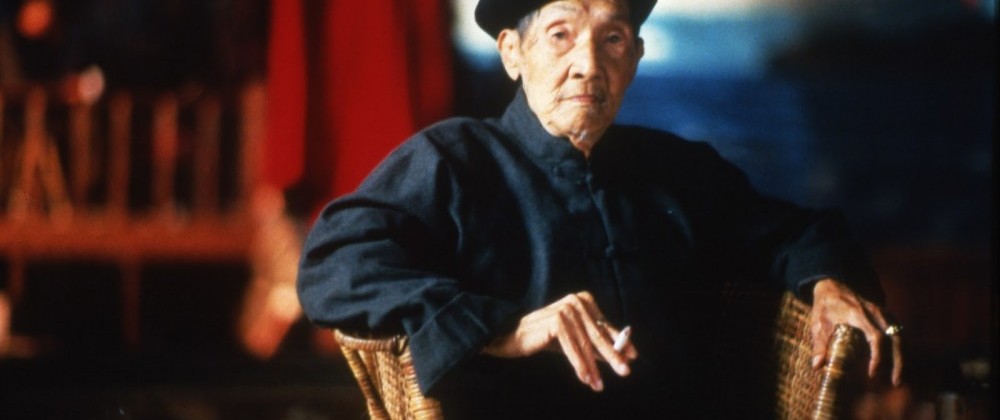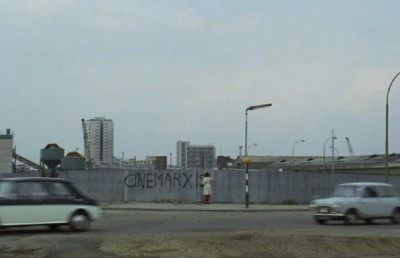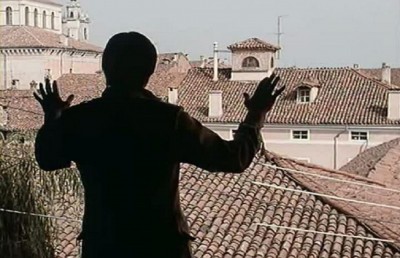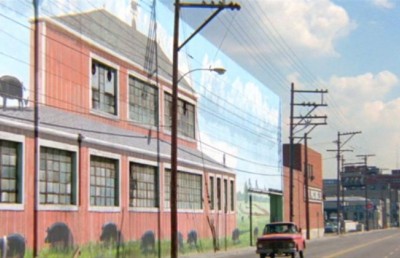A Bergsonian Personal Journey into History
Hou Hsaio-hsien's The Puppetmaster

Hou Hsaio-hsien’s bio-historical account of early 20th century Taiwan is a persuasive personal journey into history. The film registers Taiwan through the years 1910 to the end of World War 2, as seen through the eyes of actor and puppetmaster Li Tienlu, a frequent actor-collaborator with Hsaio-hsien. The following essay will demonstrate how The Puppetmaster is one of the purest Bergsonian films ever made. To do so I will draw not only from the French philosopher Henri Bergson, but from Gilles Deleuze’s Bergsonian account of film history/theory as developed in his two books, Cinema 1: Movement-Image and Cinema 2: Time-Image . Bergson was opposed to the fragmentation of time and movement (spatialization), arguing instead for time to be understood as holistic and indivisible. With this in mind, one of the more obvious Bergsonian elements of The Puppetmaster is the excessive use of the long take sequence shot, which maintains the temporal unity of a scene, in conjunction with a fixed frame and elliptical narrative structure. In the latter respect, the film recounts the tragic fate of Taiwan during 50 years of Japanese Occupation spanning the beginning of the Occupation in 1895 (mentioned in the opening intertitles), the Sino-Japanese War of 1937, and World War 2. These grand historical events are subservient to (though they affect) the family history of the voice-over narrator, Li Tienlu. When Bergson wanted to explain the difference between “being” and “becoming” and the notion of temporal flux, he used one’s personal identity as an example. How do we identify a person’s self? When a person dies, how/who do we remember them as? The young child at 5 years of age, the young adult at 30 years of age, or the older self at 80 years of age? According to Bergson we are all of them because “becoming” implies accumulation: “…to exist is to change, to change is to mature, to mature is to go on creating oneself endlessly (Bergson, Creative Evolution , 10).
One gets this sense of temporal becoming from Hsaio-hsien’s elliptical narrative structure. In the course of the film we see or hear the narrator Li Tienlu at five various stages in his life: as an old man of 84 (in the present), as a baby, as a child, as an adolescent, and as a young man. Li Tienlu’s presence is restricted to that of an offscreen narrator until 45 minutes into the film. As before, we hear his voice-over discussing an aspect of his life, but now Hsaio-hsien cuts to a startling documentary-like shot of the elderly Tienlu sitting and talking directly to the camera. There are five more such cuts to Tienlu in the present, always sitting and calmly remembering an anecdote (usually tragic) that tangentially relates to the images we see. His calm, peaceful presence nicely parallels the film’s overall understated style. What is startling about these sequence shots is that they do not feel like flashbacks or flashforwards. The film frequently shifts ahead or back in time, but the effect, aided partially by the frozen, tableau shooting style, renders the feel of a continual state of flux rather than a zigzagging in time.
The opening shot of the film is an excellent example of this sense of temporal flux, of a pure Deleuzian time-image where both the virtual (past, pure memory) and actual (present) co-exist. Before I go further into the analysis, an exposition of the Deleuze concepts I plan to use would be helpful. It is impossible to do justice to the richness and complexity of Deleuze’s two books in such small space, but I will briefly summarize the main thrust of his argument according to the needs of the present essay. The central thesis of his two books is that cinema underwent a paradigmatic shift somewhere after World War 2 (exemplified with Italian neo-realism) from a cinema of the movement-image to a cinema of the time-image (though they have always co-existed). The pre-war period movement-image (classical cinema) defined itself primarily through motion and action and subordinated time to movement. The time-image (modern cinema) moved beyond motion by freeing itself from this dependence on action, reaction, and movement (what Deleuze calls a crisis of the “sensory-motor” link on the part of the screen characters). Another important element in this shift is Deleuze’s distinction between rational and irrational cuts and shot intervals:
- The so-called classical cinema works above all through linkage of images, and subordinates cuts to this linkage….rational cuts always determine commensurable relations between series of images and thereby constitute the whole rhythmic system and harmony of classical cinema….Time here is, therefore, essentially the object of an indirect representation, according to the commensurable relations and rational cuts which organize the sequence or linkage of movement-images….modern cinema [is] defined ideally by a reversal where the image is unlinked and the cut begins to have an importance in itself. The cut …no longer forms part of either of the two series: it is the equivalent of an irrational cut, which determines the non-commensurable relations between images (Deleuze, Cinema 2: Time-Image , 213).
To summarize, the classic movement-image is based on a rational ordering system (the continuity system) that is intended to make the story as legible and smooth running as possible. Even the terms of the continuity system, the match cut, the cut on action or movement, the 180-degree line, the reaction shot, the eye-line match, etc., are variations on movement. None of these terms relate directly to time (though time is implied). This is the basis of Deleuze’s “rational” cut. In the time-image the interval between shots is not governed by such rational properties, and time is allowed to breathe and determine movement. To quote Deleuzian scholar D.W. Rodowick: “The [irrational] cut defines an unbridgeable interval….The chronological time of the movement-image fragments into an image of uncertain becoming” (Gilles Deleuze’s Time Machine , 14-15).
The cornerstone of Deleuze’s time-image is the crystal-image, an indivisible unity of the virtual image and the actual image. The virtual image is subjective, in the past, and recollected. The virtual image as “pure recollection” exists outside of consciousness, in time. It is always somewhere in the temporal past, but still alive and ready to be “recalled” by an actual image. The actual image is objective, in the present, and perceived. The crystal-image always lives at the limit of an indiscernible actual and virtual image. The crystal-image shapes time as a constant two-way mirror that splits the present into two heterogeneous directions, “one of which is launched towards the future while the other falls into the past. Time consists of this split, and it is … time, that we see in the crystal” (Cinema 2: Time-Image , 81).
Another Deleuzian concept that is relevant to The Puppetmaster is found in Deleuze’s illuminating discussion of depth-of-field (and by extension, the long take). Deleuze feels that in most cases where depth of field is necessary, there is a connection to memory. The memory link is not necessarily literal, as in a flashback, or through psychological imagery, but an attempt to evoke a memory out of an actual present; or “of the exploration of a sheet of past from which these recollection-images will later arise” (Deleuze, 109). With the poetic (and very Bergsonian) term “sheet of past” we can visualise a space where both actual and virtual image co-exist. Deleuze – as he always does with terms – expands “sheet of past” to include characters, so that each character can also represent or carry their own sheet of past which may overlap with those of others. This is especially important for The Puppetmaster . In the Deleuzian sense depth of field is understood as a “function of remembering” and as a “figure of temporalization” [that] ….gives rise to all kinds of adventures in memory, which are not so much psychological accidents as misadventures of time…”( Cinema 2: Time-Image, 110). With a working knowledge of these key Deleuzian concepts, we can know engage in a “Bergsonian” analysis of the film.
I’ll begin with a discussion of the film’s seemingly simple yet temporally complex opening. The opening intertitles set the pre-history of the film as beginning with the Japanese Occupation of Taiwan in 1895. The opening image is a 2 minute 20 second static long take tableau of the happy celebration of a baby’s first birthday. The aggregate effect of image and sound in this sequence shot is exemplary of the film’s Bergsonian temporality. Within this two plus minutes actual and virtual time fluctuates between 1895 and 1993. The present, 1993, is alive through Li Tienlu’s aged voice-over narration. He tells us that his father, marring into his mother’s family, had to renounce his family name, Ko, to that of his in-laws, Li, in his first child. His subsequent children could then adopt his surname. The narrator, Li Tienlu, was that first child. The event we witness on the image track is the narrator’s first birthday. Within a few minutes the temporality alternates between the narrator’s immediate pre-history, 1909 (his birth), 1910, (his first birthday) and 1993 (the time of the narrating). This type of simultaneous temporality occurs several times in the film, though never quite as prominently as in the beginning and end.
The intervals between shots do not follow the “rational” cutting pattern of the movement-image. The temporal (and sometimes spatial) link between shots is often immeasurable, or becomes remotely measurable only well into the shot. For example, one scene approximately 90 minutes into the film begins with a slight high angle shot looking down upon a dirt road winding along a forest area. A couple we assume to be Li Tienlu and his wife walk along the road toward the camera, getting as close as long shot range before the image fades to black. The next shot is an extreme long shot of a suspended bridge amidst gorgeous greenery. Barely visible are two or three people walking across the bridge right to left, followed by a marching band. It is impossible to ascertain with certainty the physical or temporal link between these shots.
In another sequence immeasurable intervals and irrational cutting carries the narrative across a time span of somewhere between 10-20 years in a series of approximately 16 (mainly) long take shots and 16 screen minutes. In the first shot Li Tienlu appears as a young boy learning the art of puppetry (43.45 minutes). Tienlu reappears seven shots later as an old man in the present (47.45). Two shots later we see Tienlu as a young man trying, with the help of a friend, to gain his father’s consent for marriage. The father angrily rejects his marriage proposal (56.00). Two shots later we see a group of new characters standing and sitting in a house garden. Li Tienlu enters the shot in the extreme background and is introduced to an elderly seated man (his future father-in-law Onglai) as “the bridegroom” (57.20). The scene cuts to another exterior open space location, with firecrackers popping and people seen celebrating in the extreme background. Cut to an exterior shot of a home. The offscreen sound of a woman yelling in pain is heard (a woman is giving birth) while people mill about outside the front door. Fade to black. The final shot of this “growth-to-adulthood” sequence opens inside a home with the camera angled at a staircase leading to a second floor. A young girl of about 5-7 years of age is seen seated halfway down the stairs. Li Tienlu walks down the stairs, soon followed by his wife. A baby crying is heard offscreen. The woman brusquely orders her daughter to go upstairs to look after her brother (59.00). In approximately sixteen minutes of screen time we see Li Tienlu grow from a young boy to a married man with two children. Though the necessary visual and aural information is present, it is never foregrounded and the intervals remain immeasurable (For example, how much time has elapsed between the argument with the father and the wedding? Or the marriage and the birth of their first child?) The “important” information is not, as in popular cinema, given priority in relation to other components in the image. Important information is either withheld (we don’t see the wife until the last shot) or obscured by the mise-en-scène (long shot or extreme long shot range which makes it difficult to identify characters, characters placed in profile to the camera, blocked by other characters, or obscured by darkness). When asked about this elliptical narrative structure Hsaio-hsien replied,
- When I was working on the screenplay I met the wife of a friend, whose four-year-old daughter would follow her wherever she went, even to the toilet. My own daughter, 14 years old, is in a period of rebellion and argues with her mother everyday. I thought that the juxtaposition of these two anecdotes, without any exposition of the intervening years, would render the essence of child/parent relations. This, I think, summarises my ideas toward ellipsis and my method of structuring the story (“Entretien avec Hou Hsaio-hsien: La révélation de la liberté, interview by Michel Ciment, Positif #394, December 1993, 11, my translation from French).
I will again refer to Hsaio-hsien’s own thoughts to link his aesthetics to the Deleuzian term “sheet of past.” In the same interview as quoted above Hsaio-hsien relates how moving away from traditional Western storytelling to a Chinese storytelling style liberated him and helped shape his visual style and his use of location:
- (…)I discovered that I became liberated from certain constraints: the traditional story with a beginning, middle and end, self-explanatory transitions, and the dramatic climax. I also rediscovered the spirit of classical Chinese theatre, which does not have, like in Western theatre, a clear narration where each element is in its place….I became aware that I was able to concentrate exclusively on the human soul and its emotions….I gradually developed this aesthetic of a fixed frame which comes, I feel, from my respect for people, objects, and the landscape in which I am filming….my goal is to film states of the soul, atmospheres, and moments of reflection. To achieve that I must eliminate the superfluous ( Positif #394 , December 1993, 12, my translation from French).
What became “superfluous” for Hsaio-hsien was the quick pace associated with a certain cutting style and use of camera movement. The camera rarely moves in The Puppetmaster , and when it does, it moves deliberately. Characters are more often than not sitting or standing still, and the average shot length is a remarkably high 80 seconds (up from an already very slow rate of 43 for his previous film, A City of Sadness). This sense of contemplative stillness which informs the acting, shooting and cutting style is also apparent in the lighting, the use of locations and the mise-en-scène. This conscious elimination of movement seems like a perverse reaction to the movement-image and cinema’s inherent ability to construct exciting, visceral imagery (as we see, for example, in a great deal of Hong Kong cinema). In some ways it recalls the mannered move toward aesthetic stasis noted in Paul Schrader’s “transcendental style.” 1 Closer to the source at hand, “Beyond movement means beyond the physical world towards a mental one, or one that entwines the physical and the spiritual worlds in a new way” (D.W. Rodowick, Gilles Deleuze’s Time Machine , 27).
My own understanding of “spiritual” goes beyond religious experience to include other non-material but emotionally and intellectually tangible experiences such as memory, time, death, and dying. Two articulate spokespersons for time, Henri Bergson and the Russian director Andrei Tarkovsky, both understood time and memory to be spiritual states. For Bergson pure memory (not habitual memory) forms the soul of the fundamental self. Bergson likens memory to the spirit: “When we pass from pure perception to memory, we definitely abandon matter for spirit” ( Matter and Memory , 313) “…but pure memory is a spiritual manifestation. With memory we are, in truth, in the domain of spirit “ ( Matter and Memory 320). Tarkovsky considers time and memory to be “two sides of a medal” because memory can not exist without time. Memory, like time, is complex and can never be exhausted. Without it a person would be “falling out of time” and “doomed to madness” ( Sculpting in Time , 57-58). After collapsing time and memory Tarkovsky writes: “ Memory is a spiritual concept! “ (57).
We can also see this in the way houses (the physical world) evoke memory (spiritual world) for Hsaio-hsien. When asked by Michel Ciment if evoking the past was another one of the reasons for making The Puppetmaster Hsaio-hsien replied,
- It was not deliberate, but effectively I had the sensation of engaging in a dialogue with the countryside and with the lifestyle of these simple people. I felt a great empathy with this universe. I was also very sensitive to the light of the area and the way it contrasted with darkness. This created a strong sensation of life. I rediscovered my childhood memories in the old homes in Southern China in which I filmed, with their somber and silent interiors and light falling from the ceiling. This influenced my use of single light source cinematography 2 ( Positif #394 , December 1993, 12, my translation from French).
Working alongside the elements of lighting, fixed framing, and long takes in forming a “sheet of past” in Hsaio-hsien’s time-image is the frame-within-a-frame compositional device. Nearly every interior shot is composed with multi-frames within the singular camera frame. Sometimes the camera itself looks into a room through a window or doorframe. At other times windows, room dividers, doors and doorframes, wall patterns, and wall objects appear at various planes within the image. The effect of this compositional strategy creates a visual equivalent for the “blocks” of time that form the film’s overall durational narrative structure (with duration understood as being neither linear nor chronological but a combination of any-time-whatsoever along a holistic conception of time).
Time-image as a “sheet of past” perhaps culminates in one of the final long takes in the film. In the scene before this long take we learn through a combination of voice-over narration (present) and image (past) that Li Tienlu’s father-in-law died of malaria on the same day they were evacuated at the end of the war. In the shot prior to the long take in question we see Li Tienlu’s wife kneeling in a dark room crying, we assume, because of her father’s death. On the soundtrack we hear the sound of a banging hammer. The image cuts to the source of the banging hammer: a static long take framing Li and his eldest son in the background, just outside the front door, constructing something out of wood. One minute into this shot we gain knowledge of the principal action and sound that was heard in the previous shot. In voice-over Li informs us, “My youngest son Mori died of malaria. That’s fate. I bought some boards and made a coffin. I asked a Taoist priest to bury him so he would have a quick rebirth.” At this point the shot cuts to the sixth and final shot of the narrator Li Tienlu in the “present” as he explains the relevance of the film’s final images.
Though the film’s temporality is not confusing, it does not follow conventional linear or rational narrative order. In the described long take Li and his son are in the background of the shot, perhaps a visual correlation of “pastness” in relation to the foregrounded voice-over; but the image is in the past only in relation to the voice-over narration which we know to be in the present. The static long take holds this tensional duration until the image cuts to the elderly Li in the present. Likewise, in the previous shot of Li’s wife crying we assume that she is mourning her father’s death because we have been told that he died in voice-over and we have seen images of him in his deathbed. The logic of linearity enforces this reading. However, during this shot we also hear the sounds of Li constructing a coffin for his son. This sound is located at a time following the death of their son Mori, so the wife may in fact be mourning her son’s death. In any case, the time interval in-between these two shots is immeasurable (though not confusing).
In operation with the many other formal and thematic elements noted above, we can begin to articulate a radical long take style that can be best described as “contemplative.” Through a precise and highly controlled mise-en-scène, Hsaio-hsien expresses a state of repose and introspection that exists most assuredly in his characters, but extends to his spectators. Hou Hsaio-hsien’s radical long take style in conjunction with the static framing allows the spectator’s lived temporal experience of viewing the film to seep into the film’s understated dramatic time (spectator time coalesces with filmic time). The durational time structure that fluctuates between Tienlu’s five life-stages is foremost a personal time, but one strongly informed by Taiwan’s history. The temporal gap between the final image (1945) and the voice-over narration (1993) keeps the film from ever becoming “wholly” closed or “being” (and in a state of “becoming”). To quote Gilles Deleuze, “In great film, as in any work of art, there’s always something open. And it always turns out to be time, the whole, as these appear in every different film in very different ways ( Negotiations 1972-1990, translated by Martin Joughin, Columbia University Press, New York, 1995, p. 56).
.
Notes
- Paul Schrader, Transcendental Style in Film: Ozu, Bresson, Dreyer University of California Press: Berkeley, Los Angeles, and London, 1972. In this search for a ‘sacred style’ Schrader is delineating a meticulous replacement of cinema’s potential for the ‘abundant’ (psychological realism, dramatic action, empathy) with a ‘sparse’ aesthetic, with stasis as the final stage in the process. “The transcendental style will have, it is hoped, set the viewer in motion, moving from abundant to sparse means, as if proceeding down the aisle of a Byzantine church” (Schrader, 161). The central difference between this and Hou Hsaio-hsien is that this trajectory or journey from the abundant to the sparse is not present since The Puppetmaster is ‘sparse’ to begin with. Any film that “errs” on the side of the abundant (Cecille B. De Mille’s The Ten Commandments ) or the sparse (Michael Snow’s Wavelength or The Puppetmaster ) does not entail the necessary “spiritual momentum” of the transcendental style. Schrader’s style is meant to represent a ‘sacred art’, which implies an art dedicated to a God or to a religious purpose, and that fits uneasily with a non-Western director like Hou Hsaio-hsien, or for that matter a director with an ambiguous relationship to conventional religion, such as Andrei Tarkovsky. Ozu is central to Schrader’s book, but this, again, is non-problematic only if ‘sacred’ is somehow equated with Eastern philosophical traditions and world-views (Confucianism, Taoism, Buddhism). The similarity, then, between Schrader’s transcendental style and The Puppetmaster is in one important shared affinity between transcendental style and Asian (Chinese, Japanese) aesthetics. Chinese and Japanese aesthetics strive for the Tao (the ‘Way’ of Nature), in which, “broadly speaking, aesthetic sensibilities incline towards the understated, the evocative, the lyrical, with an interest in negative capability and quiet surface. The ideal in painting is the hidden and obscure, in music the inaudible, in acting the motionless, in poetry the unstated” ( A Companion to Aesthetics , ed. David E. Cooper, Blackwell Reference, Oxford, 1992, 69). We can see an obvious parallel here to some qualities of the transcendental style: stasis, sparseness, understatement. ↩
- This use of houses and their particularities of light, tone and mood as an index for childhood memory greatly recalls the films of Andrei Tarkovsky, especially Solaris, Mirror , and Nostalghia ↩













